In the world of kitchen appliances, the commercial waffle maker has emerged as a staple for bakeries, cafes, and restaurants alike. As culinary trends evolve and consumer preferences shift, the commercial waffle maker industry has grown exponentially. This article delves into the various facets of this burgeoning market, from product innovations and market segmentation to the impact of the pandemic and future outlook. By understanding these dynamics, we can gain insight into the potential and direction of the commercial waffle maker market.
Introduction to the Commercial Waffle Maker Market
In the bustling world of commercial kitchen appliances, the commercial waffle maker has emerged as a staple for cafes, restaurants, and bakeries alike. These appliances are not just about serving a classic breakfast treat; they’ve become a symbol of innovation, efficiency, and the quest for culinary excellence. Let’s dive into the fascinating realm of the commercial waffle maker market.
The commercial waffle maker market is witnessing a surge in demand, driven by a growing affinity for the iconic Belgian waffle, as well as other regional varieties. These waffles, with their intricate patterns and fluffy texture, are not just a snack; they’ve become a signature dish for many establishments looking to offer something unique and memorable to their customers.
One of the key factors fueling this market’s growth is the increasing popularity of breakfast cafes and themed restaurants. These venues are always on the lookout for new items to add to their menu that can set them apart from the competition. The commercial waffle maker fits this bill perfectly, allowing for the creation of a product that is both visually appealing and delicious.
Moreover, the versatility of commercial waffle makers cannot be overstated. They are not limited to just waffles; many models can produce a variety of foods, from pancakes to pita bread, making them a valuable asset in any commercial kitchen. This adaptability has opened up new opportunities for chefs and culinary entrepreneurs to experiment with recipes and offer diverse menu items.
In terms of technology, the commercial waffle maker market has seen significant advancements. Modern models come with features such as adjustable temperature controls, non-stick surfaces, and even automatic shut-off functions to prevent burns. These innovations have not only made the waffle-making process safer and more efficient but have also improved the quality of the final product.
Geographically, the market is divided into Europe and North America, with each region contributing to the overall growth in unique ways. In Europe, there’s a strong emphasis on quality and innovation, with manufacturers focusing on eco-friendly materials and energy-efficient designs. Meanwhile, North America is characterized by a more diverse consumer base, with varying preferences that drive the demand for different types of waffle makers.
The competitive landscape of the commercial waffle maker market is quite dynamic. There are several key players that have established themselves as leaders in the industry. These companies not only offer a range of products but also provide comprehensive support services, including maintenance, repair, and training for their customers.
When it comes to product innovations, the industry has seen some remarkable developments. Smart waffle makers with digital displays and touch controls are becoming more common, offering operators a level of convenience that was once only available in high-end residential models. Additionally, there’s a growing trend towards customization, with some manufacturers offering waffle makers that can be fitted with interchangeable plates to produce different shapes and sizes.
In terms of market segmentation, commercial waffle makers can be categorized based on their size, power, and features. From countertop models suitable for small cafes to large, industrial-grade units for high-volume operations, there’s a wide array of options available to meet the needs of different businesses.
Distribution channels for commercial waffle makers are also evolving. While traditional sales through kitchen supply stores remain strong, there’s an increasing trend towards online sales, where businesses can find a wider variety of products and compare prices easily.
Consumer trends and preferences are also shaping the commercial waffle maker market. Health-conscious consumers are driving demand for waffles made with whole grains and natural ingredients, while the rise of gluten-free diets has prompted some manufacturers to develop waffle makers that can produce waffles without gluten.
The impact of the COVID-19 pandemic on the commercial waffle maker market has been multifaceted. While lockdowns and reduced dining-out options initially dampened demand, the pandemic also highlighted the importance of home cooking, leading to an increased interest in commercial-grade appliances for home use.
Looking ahead, the commercial waffle maker market is poised for continued growth. As consumer tastes continue to diversify and technology advances, we can expect to see even more innovative and efficient waffle makers hitting the market. The future of the commercial waffle maker industry is bright, with endless possibilities for culinary creativity and business success.

The Rise of the Waffle Maker Industry in the Western Markets
The commercial waffle maker industry has seen a remarkable surge in popularity, particularly in the Western markets. This upward trend can be attributed to several factors, each contributing to the growth and evolution of this niche sector.
-
Culinary Culture and Gourmet TrendsIn Western countries, there is a strong emphasis on culinary culture and gourmet experiences. The rise of food blogs, cooking shows, and social media platforms has fueled a fascination with unique and indulgent dishes. Waffles, with their versatility and ability to be dressed up in countless ways, have become a staple in this culinary landscape.
-
Convenience and Quick ServiceThe fast-paced lifestyle of many Western consumers has led to a demand for convenience. Commercial waffle makers cater to this need by providing a quick and easy solution for restaurants, cafes, and catering services. These appliances allow businesses to serve freshly made waffles to customers without the long preparation times associated with traditional methods.
-
Versatility in Flavors and StylesCommercial waffle makers have expanded their offerings beyond the classic Belgian waffle. Today, these appliances can produce a variety of shapes, sizes, and flavors, from the traditional to the whimsical. This versatility has allowed for creative menu options and has appealed to a broader customer base.
-
Health and Wellness MovementThe health and wellness movement has also played a significant role in the growth of the commercial waffle maker industry. As consumers seek out healthier alternatives to traditional breakfast items, waffles have been reimagined with whole grains, protein, and reduced sugar. This has opened up new markets for businesses looking to cater to health-conscious diners.
-
Popularity of Breakfast DinersBreakfast diners have been a staple in Western culture for decades. The popularity of these establishments has surged, and commercial waffle makers have become a must-have appliance. These diners offer a range of waffle options, from sweet to savory, making them a favorite among breakfast enthusiasts.
-
Event Catering and Special OccasionsSpecial occasions and corporate events have also contributed to the growth of the commercial waffle maker industry. The ability to serve large quantities of waffles in a short amount of time has made these appliances a favorite among caterers. From wedding breakfasts to corporate retreats, waffles have become a go-to dish for creating memorable experiences.
-
Expansion into Non-Traditional MarketsThe success of the commercial waffle maker industry in Western markets has prompted manufacturers to explore new territories. International expansion has led to the introduction of waffle makers in countries where the tradition of waffles is not as deeply rooted. This has helped to further establish the waffle as a global phenomenon.
-
Collaborations with Chefs and InfluencersTo stay ahead in the competitive market, commercial waffle maker brands have started collaborating with renowned chefs and culinary influencers. These partnerships have allowed for the creation of signature waffle recipes and innovative designs, which have in turn attracted a new wave of consumers interested in home waffle-making.
-
Technological AdvancementsAdvancements in technology have also played a crucial role in the rise of the commercial waffle maker industry. Modern appliances are equipped with features like non-stick surfaces, adjustable temperature controls, and easy-to-clean designs. These innovations have made waffle-making more accessible and appealing to a wider audience.
-
The Role of Seasonal TrendsSeasonal trends have also had a significant impact on the commercial waffle maker industry. During the holidays, waffles often take center stage in festive menus, leading to increased demand. This seasonal fluctuation has provided manufacturers with a stable and predictable market.
-
Conclusion of the Waffle Maker’s AscentIn conclusion, the commercial waffle maker industry’s rise in the Western markets is a testament to the evolving culinary landscape, consumer preferences, and technological advancements. As the industry continues to grow, it is likely that we will see even more innovation and expansion in the years to come.
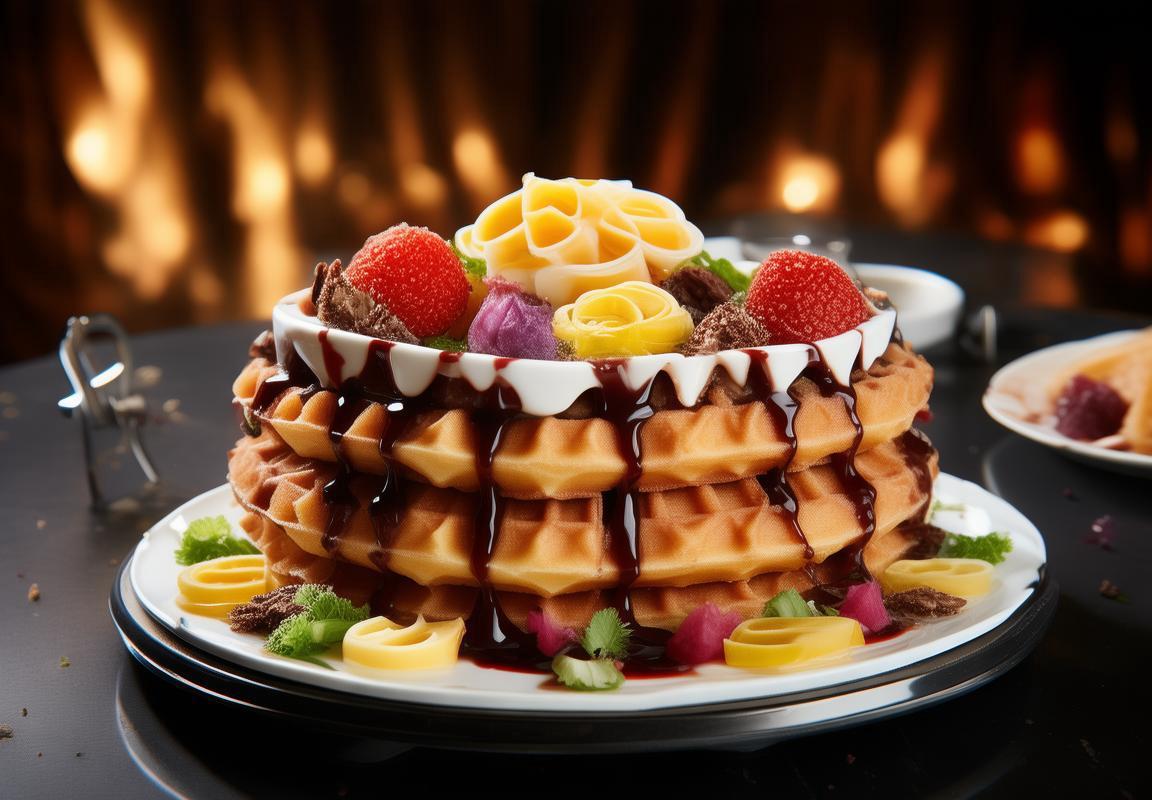
Market Dynamics: Drivers and Challenges
The commercial waffle maker industry has seen a remarkable surge in the Western markets, propelled by a variety of factors that have not only fueled growth but also introduced new complexities. From consumer preferences to technological advancements, here’s an exploration of the key dynamics at play.
The surge in demand for commercial waffle makers is largely driven by a shift in consumer behavior. As people become more health-conscious, seeking out alternatives to traditional breakfast items like pancakes, waffles have emerged as a popular choice. The convenience of making waffles at home or in commercial settings has made them a staple in the morning menu for many.
Culinary trends have also played a significant role in the growth of the waffle maker market. With the rise of breakfast cafes and the increasing popularity of gourmet and artisanal foods, the demand for unique and high-quality waffles has skyrocketed. Chefs and bakers are now experimenting with different waffle designs, flavors, and toppings, which has further sparked interest in commercial waffle makers.
Economic factors have also contributed to the market’s upward trajectory. As the cost of living increases, consumers are looking for more cost-effective breakfast options. Waffle makers offer a solution that allows individuals to create their own custom waffles at a fraction of the cost of dining out or buying pre-made waffles.
The commercial sector itself has been a major driver, as restaurants, hotels, and event venues seek to offer unique menu items that differentiate them from competitors. The versatility of commercial waffle makers, which can produce a variety of waffle patterns and sizes, has made them a valuable tool for creating distinctive breakfast and dessert offerings.
However, challenges abound in the market dynamics. One of the most significant hurdles is the high cost of some commercial waffle makers, which can be prohibitive for small businesses and startups. Additionally, the initial investment in equipment and ingredients to start a waffle-based business can be daunting.
Maintenance and durability are also critical considerations. Commercial waffle makers are subjected to heavy use, which can lead to frequent repairs or replacements if the units are not well-built or properly maintained. This ongoing operational cost can be a substantial drain on resources for businesses already investing in quality appliances.
Another challenge is the competitive landscape. With numerous brands and models available, it can be difficult for manufacturers to stand out. Consumers and businesses are bombarded with options, and differentiation can be tricky, especially when it comes to the actual performance and reliability of the waffle makers.
Regulatory compliance poses yet another challenge. In the Western markets, particularly in the United States and Canada, there are strict safety and hygiene regulations that commercial kitchen equipment must adhere to. Ensuring that waffle makers meet these standards requires extensive research, development, and quality control measures.
Innovation and technology are also key factors affecting market dynamics. While advancements have made waffle makers more efficient and user-friendly, they have also led to increased complexity. New features such as non-stick surfaces, digital controls, and programmable settings have become standard, but they also add to the cost and the learning curve for users.
Moreover, the environmental impact of commercial waffle makers is a growing concern. As awareness of sustainability grows, businesses are looking for more eco-friendly options. This trend may lead to a shift in demand towards appliances made with recycled materials or with a lower carbon footprint.
Lastly, the rise of health consciousness extends beyond the ingredients to include the manufacturing processes. Consumers are increasingly interested in the origins of their products and the practices of the companies that produce them. This has created a demand for transparency and ethical sourcing, which can impact how commercial waffle makers are designed and marketed.
In summary, while the commercial waffle maker industry in the Western markets has experienced substantial growth, it is not without its challenges. From the cost and complexity of the products to regulatory compliance and consumer expectations, manufacturers must navigate a complex landscape to succeed.
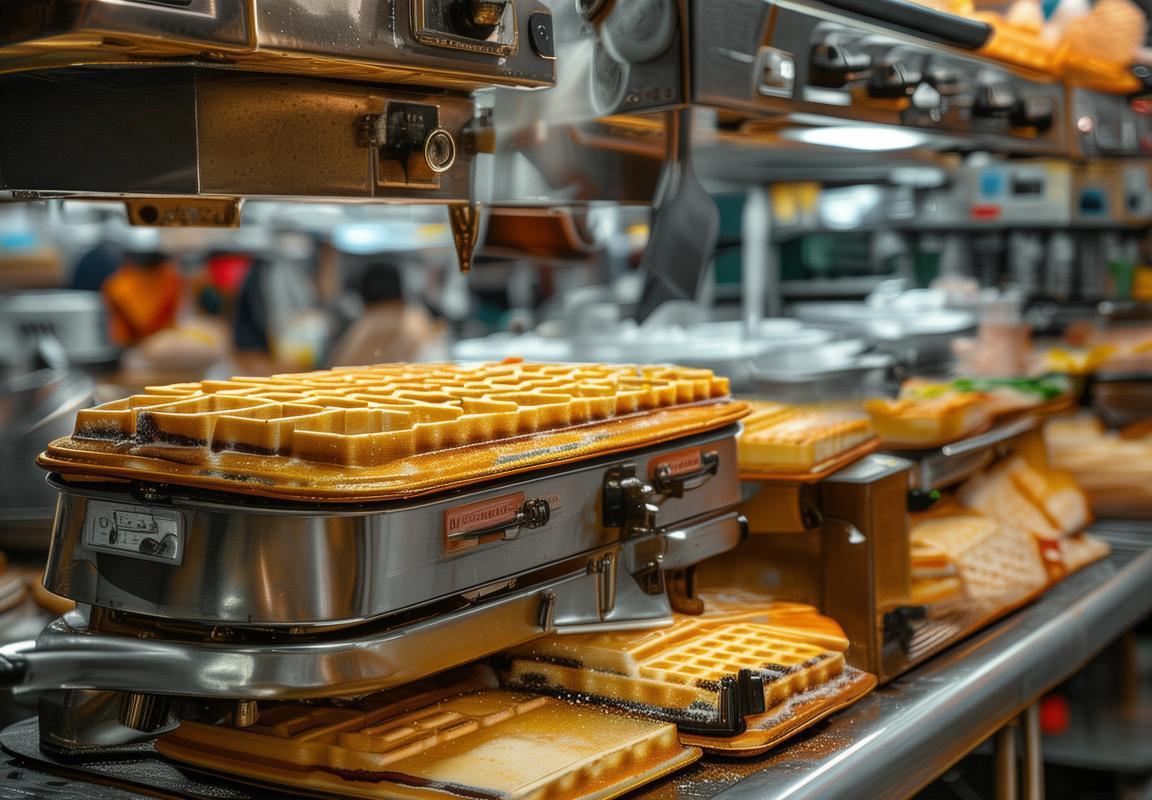
Key Players in the European and North American Commercial Waffle Maker Industry
In the European and North American commercial waffle maker industry, several key players have established themselves as leaders, each bringing unique strengths and innovations to the market. From well-known household names to emerging brands, these companies are shaping the landscape with their products and strategies.
Cuisinart, a brand synonymous with kitchen appliances, has a strong presence in the commercial waffle maker market. Known for their durable and reliable products, Cuisinart offers a range of commercial waffle makers that cater to various needs, from small cafes to large restaurants. Their commitment to quality and innovation has earned them a loyal customer base.
Breville, another prominent player, has made a name for itself with its high-quality, Australian-designed appliances. Their commercial waffle makers are often praised for their even heating and non-stick surfaces, making them a favorite among professional chefs and home bakers alike. Breville’s focus on creating versatile and efficient machines has helped them carve out a niche in the market.
Hamilton Beach, a brand that has been around for over a century, offers a wide array of commercial waffle makers suitable for different types of establishments. From countertop models to heavy-duty commercial units, Hamilton Beach’s products are known for their affordability and ease of use. Their extensive product line caters to a broad customer base, from small businesses to large-scale operations.
The Belgian waffle maker market is dominated by brands like Presto and Krups. Presto’s commercial waffle makers are celebrated for their affordability and ease of operation, making them a go-to choice for many small-scale operations. Krups, on the other hand, offers a range of high-end commercial waffle makers that are favored for their precision and design. Both brands have built a reputation for producing durable and consistent waffle makers that meet the demands of busy kitchens.
In the North American market, Black & Decker has a significant presence with their commercial waffle makers. Known for their affordability and versatility, Black & Decker’s products are often chosen for their ability to produce a variety of waffle styles. Their commitment to providing value to the consumer has made them a trusted name in the industry.
Danby, another brand with a strong presence in the North American market, offers a range of commercial waffle makers that are both stylish and functional. Their products are designed to be durable and easy to clean, making them a popular choice for commercial kitchens looking for a reliable waffle-making solution.
As the industry continues to grow, several new players have emerged, bringing fresh ideas and technologies to the table. Companies like Chef’sChoice and Sunbeam have been making waves with their innovative designs and focus on energy efficiency. Their commitment to creating waffle makers that are not only effective but also environmentally friendly has resonated with consumers and businesses alike.
In the world of commercial waffle makers, the competition is fierce, but it’s also a testament to the demand for high-quality, versatile, and durable appliances. The key players in the European and North American markets have each contributed to the evolution of the industry, offering a wide range of options that cater to the diverse needs of consumers and businesses. Whether it’s for a small café or a bustling restaurant, these brands have become synonymous with the art of waffle making, ensuring that every bite is a delightful experience.
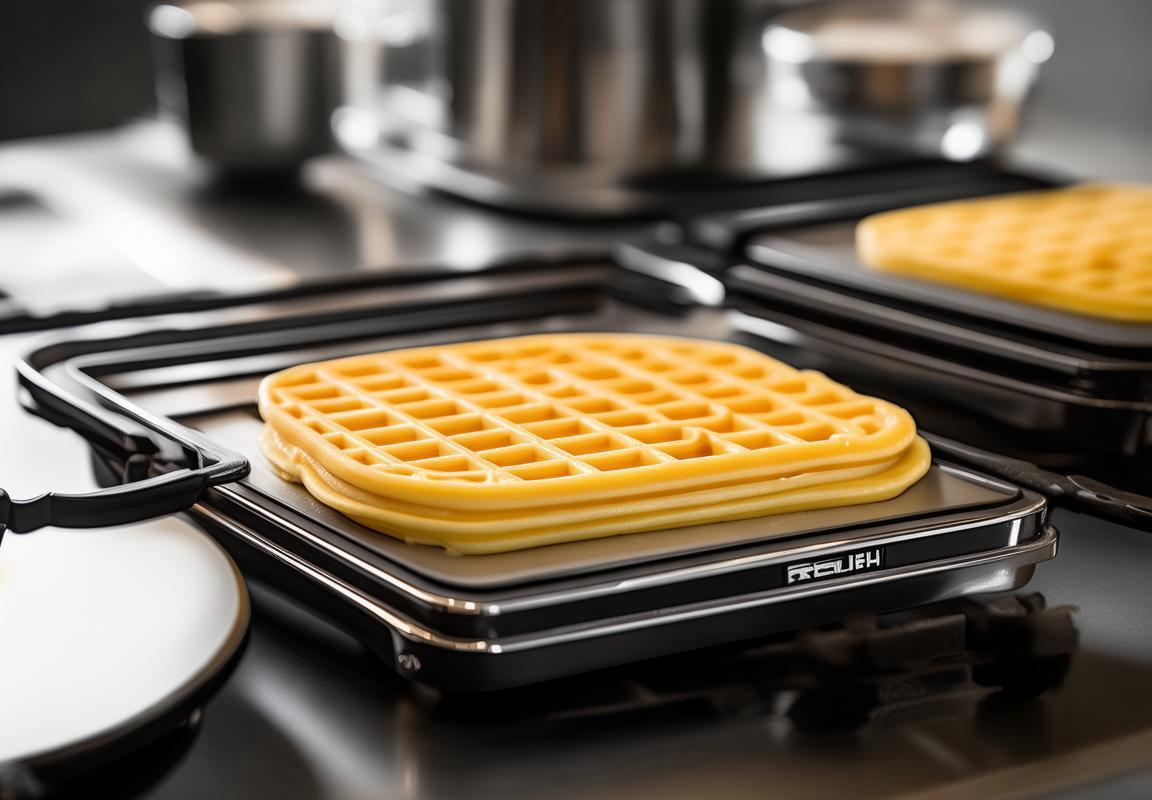
Product Innovations and Technological Advancements
The commercial waffle maker market has seen a surge in innovation, with manufacturers pushing the boundaries of what these appliances can offer. Here’s a glimpse into some of the latest trends and technological advancements:
Waffle designs have evolved beyond the traditional square or round patterns. Manufacturers are now experimenting with more intricate shapes and even custom designs, allowing cafes and bakeries to offer unique and visually appealing waffles to their customers.
Smart features are becoming increasingly common in commercial waffle makers. Integrated timers, temperature controls, and even Bluetooth connectivity are being integrated to ensure precise cooking and the ability to remotely manage waffle production.
One of the latest trends is the inclusion of non-stick coatings that are more durable than traditional options. These coatings are designed to last longer, reducing the need for frequent replacements and maintenance.
Energy efficiency is a growing concern, and manufacturers are responding with appliances that consume less power while still delivering high-quality waffles. Energy-saving features and certifications are becoming standard in new models.
Some waffle makers are now equipped with programmable settings that allow users to save their preferred cooking times and temperatures. This not only streamlines the process but also ensures consistency in the final product.
Innovative materials are being used to create waffle makers that are not only durable but also easy to clean. Materials like stainless steel and high-quality plastics are replacing traditional metals and plastics, enhancing the longevity and aesthetics of the appliances.
The rise of health-conscious consumers has spurred the development of waffle makers that can produce healthier waffles. This includes models with adjustable browning controls and the ability to use alternative cooking surfaces like cast iron, which can reduce the fat content.
Waffle makers are now not just for batter-based waffles; some models can handle a variety of ingredients, from fruit purees to chocolate. This versatility allows for the creation of dessert waffles, savory waffles, and even gluten-free options.
The integration of baking elements into waffle makers is another advancement. Some units come with additional attachments for baking cookies or even pizza, expanding their utility beyond just waffle production.
Customization is key in the commercial market, and manufacturers are responding with waffle makers that can produce waffles with different patterns and textures. This can cater to a wider range of tastes and dietary preferences.
In terms of safety, new waffle makers are incorporating features like automatic shut-off to prevent overheating and potential fires. This added layer of security is crucial in a commercial setting where safety is paramount.
The commercial waffle maker industry is also seeing the adoption of eco-friendly practices. From recyclable packaging to appliances that use less water and energy, sustainability is becoming a cornerstone of product development.
Finally, the integration of data analytics is starting to make its way into the commercial waffle maker market. This allows businesses to track usage patterns, maintenance schedules, and even customer feedback, leading to more informed product development and operational strategies.
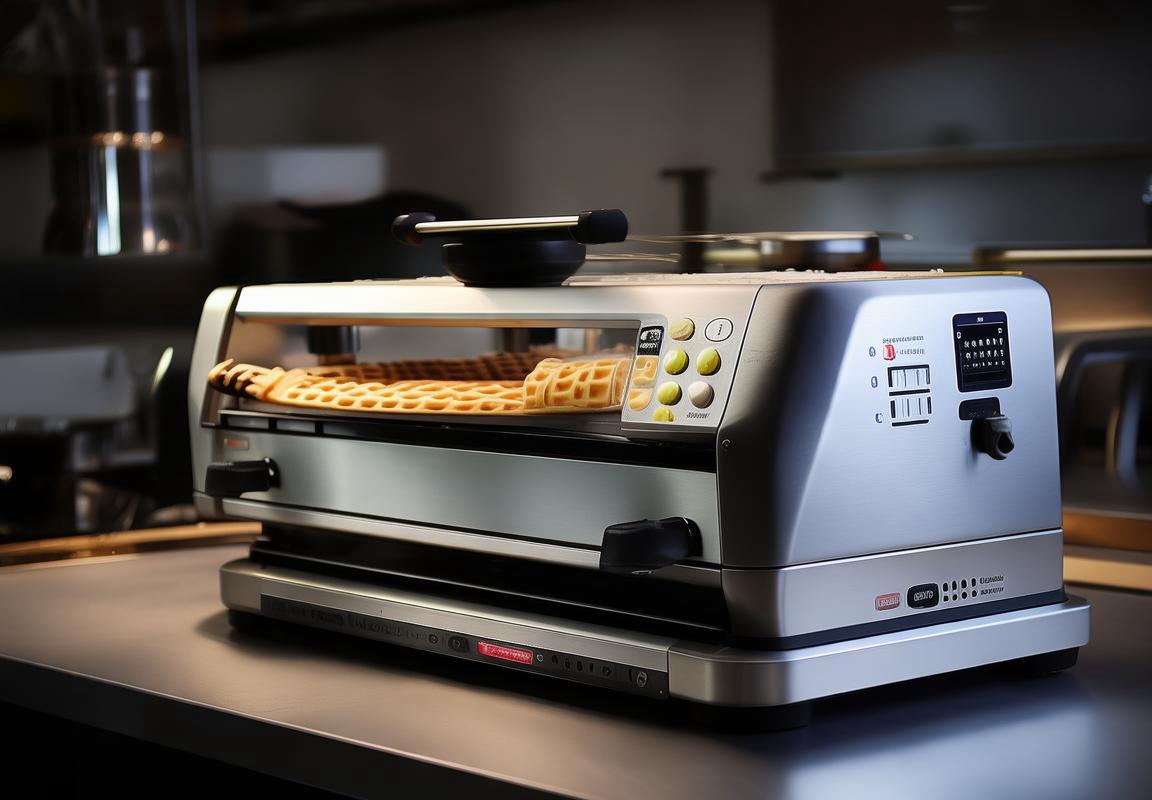
Market Segmentation: Types of Commercial Waffle Makers
In the commercial waffle maker market, segmentation plays a crucial role in understanding the diverse needs and preferences of various customers. Here’s a breakdown of the different types of commercial waffle makers available:
-
Traditional Belgian Waffle MakersThese classic waffle makers are designed to produce the iconic Belgian waffles with their distinctive deep pockets. They come in various sizes, ranging from small countertop models perfect for cafes and small restaurants to larger commercial units capable of serving a crowd. The key features include non-stick surfaces for easy release and consistent heat distribution to ensure the perfect texture and crispness.
-
Flat Waffle MakersFlat waffle makers, also known as American waffle makers, are widely used in commercial settings due to their simplicity and versatility. They produce waffles with a flat, even surface, making them ideal for sandwiches, toppings, or simply as a side dish. These machines are often equipped with adjustable temperature controls to achieve the desired level of crispiness, and they come in various sizes to accommodate different kitchen needs.
-
Mini Waffle MakersMini waffle makers are perfect for creating bite-sized waffles, often seen in breakfast bars, buffets, and catering services. They are compact and efficient, allowing for quick production of individual waffles that are perfect for a variety of applications, from desserts to savory snacks. These units are often battery-operated or have a small countertop footprint, making them highly portable and adaptable to different service environments.
-
Pancake Waffle MakersCombining the functionality of a pancake griddle with a waffle maker, these versatile units are designed for those who want to offer both pancakes and waffles on their menu. They typically feature a non-stick surface and a removable grid that can be flipped to cook pancakes on one side and waffles on the other. This dual-purpose design is particularly popular in breakfast cafes and diners where space is at a premium.
-
Belgian Crisp Waffle MakersThese specialized waffle makers are designed to produce Belgian waffles with a crispier texture. They often come with a unique feature that allows for more even cooking, resulting in a waffle that is both soft on the inside and crispy on the outside. This type of machine is favored by establishments looking to offer a gourmet waffle experience that stands out from the traditional Belgian waffle.
-
Stuffed Waffle MakersStuffed waffle makers have gained popularity for their ability to create waffles with a hollow center, allowing for the insertion of fillings like meat, cheese, or fruit. This innovation is particularly appealing to restaurants and cafes aiming to offer unique and visually appealing dishes that can be customized to cater to different tastes and dietary preferences.
-
Self-Cleaning Waffle MakersIn an era where efficiency and convenience are key, self-cleaning waffle makers have emerged as a sought-after feature. These machines are designed to simplify the cleaning process by using steam or water to loosen food particles, making it easier to clean the surface without the need for harsh chemicals or extensive scrubbing.
-
Countertop vs. Commercial CountertopCommercial waffle makers are available in both countertop and built-in models. Countertop units are typically more portable and require less installation, making them ideal for smaller operations like cafes and food trucks. On the other hand, built-in models are designed for larger commercial kitchens, offering a more permanent and integrated solution that can handle high-volume production.
-
Electric vs. GasThe commercial waffle maker market also features a choice between electric and gas-powered models. Electric waffle makers are generally easier to use and maintain, with consistent heat distribution and temperature control. Gas-powered machines, however, can offer faster cooking times and are often preferred for their durability and ability to handle higher temperatures.
-
Customization and SpecializationLastly, some commercial waffle makers are designed with specific applications in mind, such as creating waffles with intricate patterns or for specialized diets. These customized machines can be tailored to the unique needs of certain establishments, ensuring that they can offer a wide range of waffle options to their customers.
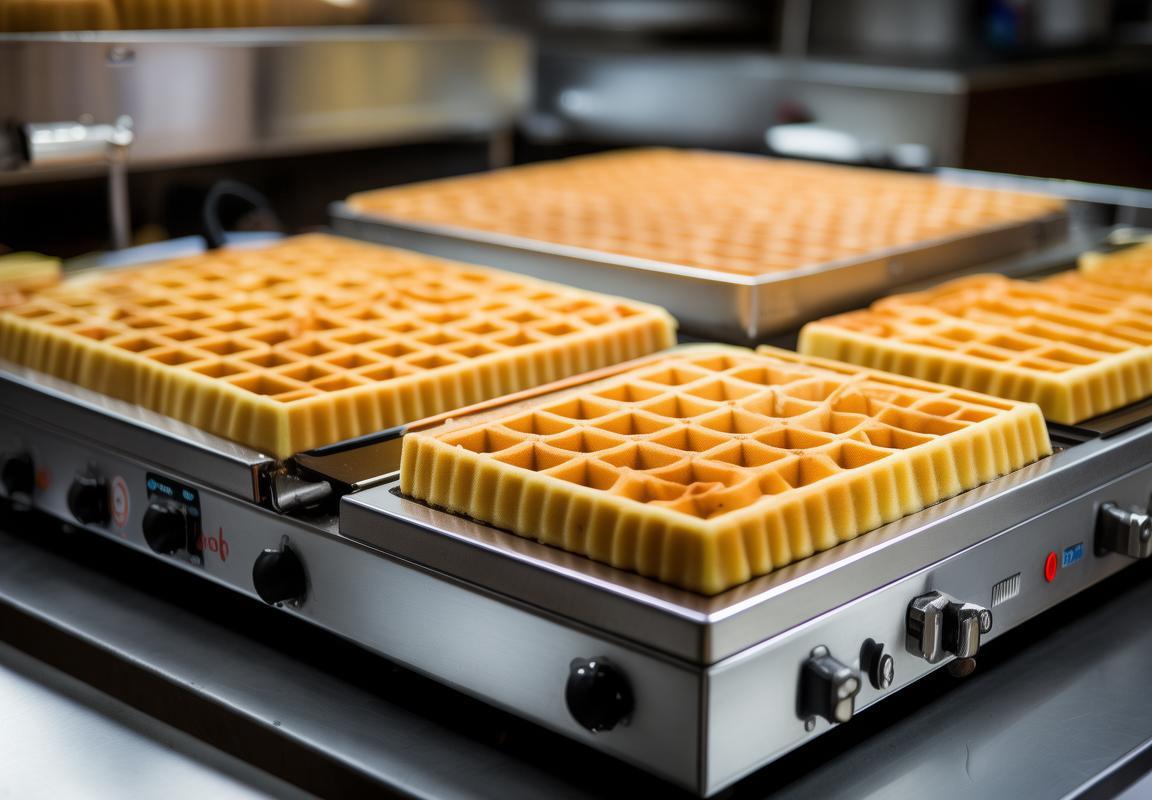
Distribution Channels and Sales Strategies
The commercial waffle maker industry has seen a surge in the European and North American markets, driven by various factors and facing several challenges. Key players in these regions have adapted and innovated to cater to evolving consumer demands and preferences. This segment explores the distribution channels and sales strategies employed by these key players.
In the United States, one of the largest markets for commercial waffle makers, distribution channels have expanded significantly. Retail stores, both brick-and-mortar and online, have become pivotal in reaching consumers. Major retail chains such as Walmart, Target, and Bed Bath & Beyond offer a wide array of commercial waffle makers from various brands, making them easily accessible to customers.
On the online front, marketplaces like Amazon have emerged as dominant platforms for selling commercial waffle makers. Brands leverage the vast customer base and ease of purchasing to gain exposure and sales. Amazon’s FBA (Fulfillment by Amazon) program has been particularly beneficial for manufacturers, allowing them to reach customers with minimal logistical overhead.
In Europe, the landscape is somewhat different, with a greater emphasis on specialty kitchen stores and departmental chains. High-end markets in countries like Germany and the UK have seen a rise in the popularity of commercial waffle makers, with customers seeking out the latest technology and premium designs. Department stores like John Lewis and departmental chains like Media Markt and Karstadt often carry a variety of commercial waffle makers.
The rise of home chefs and the foodie culture has also influenced distribution channels. Local markets, farmers’ markets, and culinary events have become platforms for niche brands to showcase their waffle makers. These venues provide an opportunity for manufacturers to connect with customers and build brand loyalty through personal interaction.
Sales strategies in the commercial waffle maker industry often revolve around highlighting product features and benefits. Brands emphasize the convenience, versatility, and efficiency of their waffle makers to appeal to busy consumers. Marketing campaigns frequently focus on how the appliances can simplify meal preparation and enhance culinary experiences.
In the United States, brands use influencer partnerships to create buzz around their products. Social media influencers, particularly those with a focus on cooking and baking, showcase how commercial waffle makers can be used to create impressive dishes. This strategy not only promotes the product but also taps into the growing trend of DIY cooking and home entertainment.
In Europe, there’s a strong emphasis on sustainability and eco-friendly products. Brands that promote their commercial waffle makers as energy-efficient or made with sustainable materials gain a competitive edge. Sales strategies in this region often include showcasing the environmental impact of their products, aligning with the values of the eco-conscious consumer.
Direct-to-consumer (DTC) sales have also gained traction. Many manufacturers have created their own online stores or partner with e-commerce platforms to sell directly to consumers. This approach allows for a more personalized shopping experience and higher profit margins, as the middleman is eliminated.
Customer service and warranties are crucial in the commercial waffle maker industry. Brands that offer exceptional customer support and reliable warranties build trust and loyalty. Sales strategies often include highlighting the post-purchase service and the longevity of their products.
As the commercial waffle maker market continues to grow, distribution channels and sales strategies are evolving to meet changing consumer needs. The industry is witnessing a blend of traditional and innovative approaches, with a focus on building strong relationships with customers through quality products, effective marketing, and reliable service.

Consumer Trends and Preferences
The commercial waffle maker market has seen a surge in consumer interest, with a variety of factors influencing the growth and direction of this niche industry. From the increasing popularity of waffles in cafes and restaurants to the rise of home baking enthusiasts, here are some key consumer trends and preferences shaping the market.
-
Health and Wellness FocusConsumers today are more health-conscious than ever before, leading to a growing demand for healthier options. This trend has extended to the waffle maker market, with consumers seeking appliances that can produce waffles made with whole grains, gluten-free flour, or alternative sweeteners like honey or maple syrup.
-
Convenience and SpeedWith busy lifestyles, there’s a strong preference for convenience and speed in cooking appliances. Commercial waffle makers that can quickly and easily produce a batch of waffles are becoming increasingly popular. Features like non-stick surfaces and programmable settings that allow for one-touch operation are highly valued by time-pressed consumers.
-
Customization and PersonalizationCustomers are looking for ways to customize their meals, and this extends to waffles as well. The ability to create different shapes, sizes, and patterns on waffles has become a selling point. Additionally, the rise of DIY and home baking culture has led to a demand for waffle makers that can produce unique and personalized designs.
-
Eco-Friendly and Sustainable ProductsThe environmental movement has influenced consumer preferences, with more people seeking out eco-friendly and sustainable products. Commercial waffle makers that are energy-efficient, made from recycled materials, or designed for longevity are gaining traction in the market.
-
Versatility in FunctionalityConsumers are not just looking for waffle makers; they want appliances that can serve multiple purposes. The integration of additional features such as griddle surfaces, pancake options, or even the ability to make other baked goods like cookies or bread has become a significant factor in the purchasing decision.
-
Social Media and Influencer InfluenceSocial media has become a powerful tool for influencing consumer preferences. Influencers and food bloggers often showcase their creations using various kitchen appliances, including commercial waffle makers. The visual appeal of these posts can drive interest and sales, as consumers are inspired by the creativity and variety of waffle designs.
-
Value for MoneyPrice remains a crucial factor in the consumer’s decision-making process. While there is a segment of the market that is willing to pay a premium for high-quality, durable appliances, there is also a significant portion of consumers looking for affordable options that deliver on performance and reliability.
-
Multi-Cultural FlavorsThe globalization of food has led to a diverse range of culinary influences in the waffle maker market. Consumers are interested in appliances that can cater to different cultural preferences, such as Belgian-style waffles, American-style waffles, or even waffles with a twist of international flavors.
-
Quality and DurabilityWith the increasing frequency of appliance purchases, consumers are placing a greater emphasis on the quality and durability of their waffle makers. Longevity, ease of maintenance, and the ability to withstand regular use are key considerations for those looking to invest in a quality appliance.
-
Innovation and DesignFinally, the aesthetic appeal of a waffle maker plays a role in consumer preferences. Modern designs, sleek lines, and innovative features can make a waffle maker not just a functional kitchen tool but also a stylish addition to the home.
These trends and preferences reflect the evolving landscape of the commercial waffle maker market, with manufacturers needing to adapt to changing consumer demands to stay competitive.
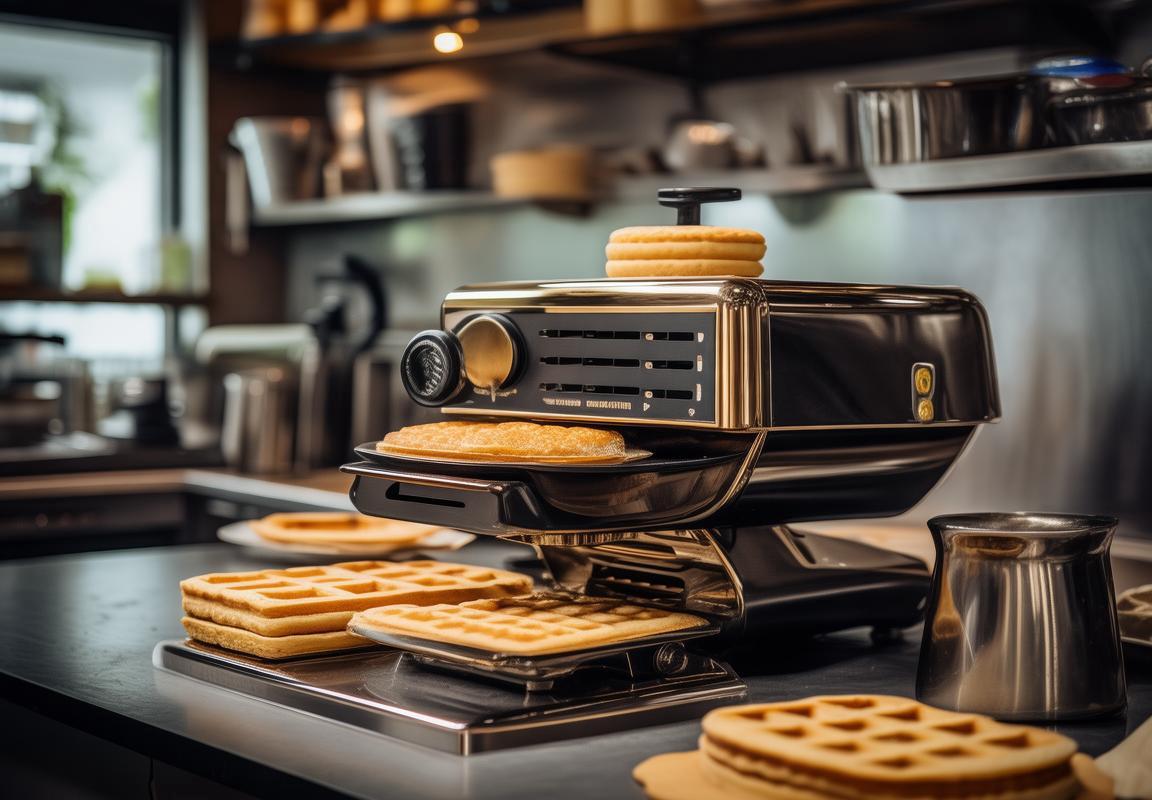
Impact of the Pandemic on Commercial Waffle Makers
The outbreak of the pandemic sent ripples through every industry, including the commercial waffle maker market. As consumers adjusted to new ways of living and working, their preferences and buying behaviors shifted dramatically. Here’s how the pandemic impacted the commercial waffle maker industry:
The Shift Towards Home EntertainmentDuring lockdowns and social distancing measures, families found themselves at home for extended periods. This shift led to a surge in home entertainment activities, including cooking and baking. Waffle makers, once seen as a weekend treat, became a staple in many kitchens. The convenience and nostalgia associated with waffles contributed to their popularity during this time.
Increased Demand for Multi-FunctionalityThe pandemic highlighted the importance of versatility in kitchen appliances. Commercial waffle makers that could serve dual purposes, such as having non-stick surfaces or the ability to cook other breakfast items, experienced a significant increase in demand. Consumers were looking for appliances that could provide more value with minimal effort.
Health and Hygiene ConcernsAs hygiene became a paramount concern, the commercial waffle maker market saw a rise in products featuring easy-to-clean designs. Makers with removable plates, dishwasher-safe components, and surfaces that were less prone to harboring bacteria were in high demand. The focus on health and cleanliness extended beyond just the waffle makers themselves; it also influenced the packaging and storage of the appliances.
Online Sales and Direct-to-Consumer ModelsWith brick-and-mortar stores experiencing temporary closures or reduced foot traffic, online sales became the lifeline for many businesses. The pandemic accelerated the shift towards e-commerce, as manufacturers and retailers turned to online platforms to reach customers. Some brands even adopted direct-to-consumer (D2C) models, selling directly to consumers without intermediaries, which allowed for better control over pricing and customer experience.
The Role of Social Media and InfluencersSocial media played a crucial role in promoting commercial waffle makers during the pandemic. Influencers and content creators shared their baking and cooking adventures, often featuring waffle makers in their posts and videos. This organic marketing strategy helped create a buzz around the products and influenced consumer purchasing decisions.
Supply Chain DisruptionsThe pandemic also exposed vulnerabilities in global supply chains. Manufacturers faced challenges in obtaining raw materials and components, leading to production delays and increased costs. The disruption in logistics further complicated the situation, with delays in shipping and distribution affecting inventory levels and product availability.
Focus on Local ProductionTo mitigate the impact of supply chain disruptions, some manufacturers shifted their focus to local production. By sourcing materials and manufacturing within their own regions, they aimed to reduce dependence on international suppliers and minimize the risk of future disruptions.
Rise of Subscription ServicesAs people became accustomed to receiving goods at their doorstep, subscription services gained traction. Some commercial waffle maker brands started offering monthly subscription boxes with new models, accessories, and recipe guides. This approach provided a steady revenue stream and helped customers stay updated with the latest innovations in the market.
The pandemic has reshaped the commercial waffle maker industry, emphasizing the importance of adaptability, versatility, and consumer-centric strategies. While the market faced numerous challenges, it also presented opportunities for growth and innovation. As the world continues to navigate through these unprecedented times, the commercial waffle maker industry is poised to emerge stronger and more resilient.
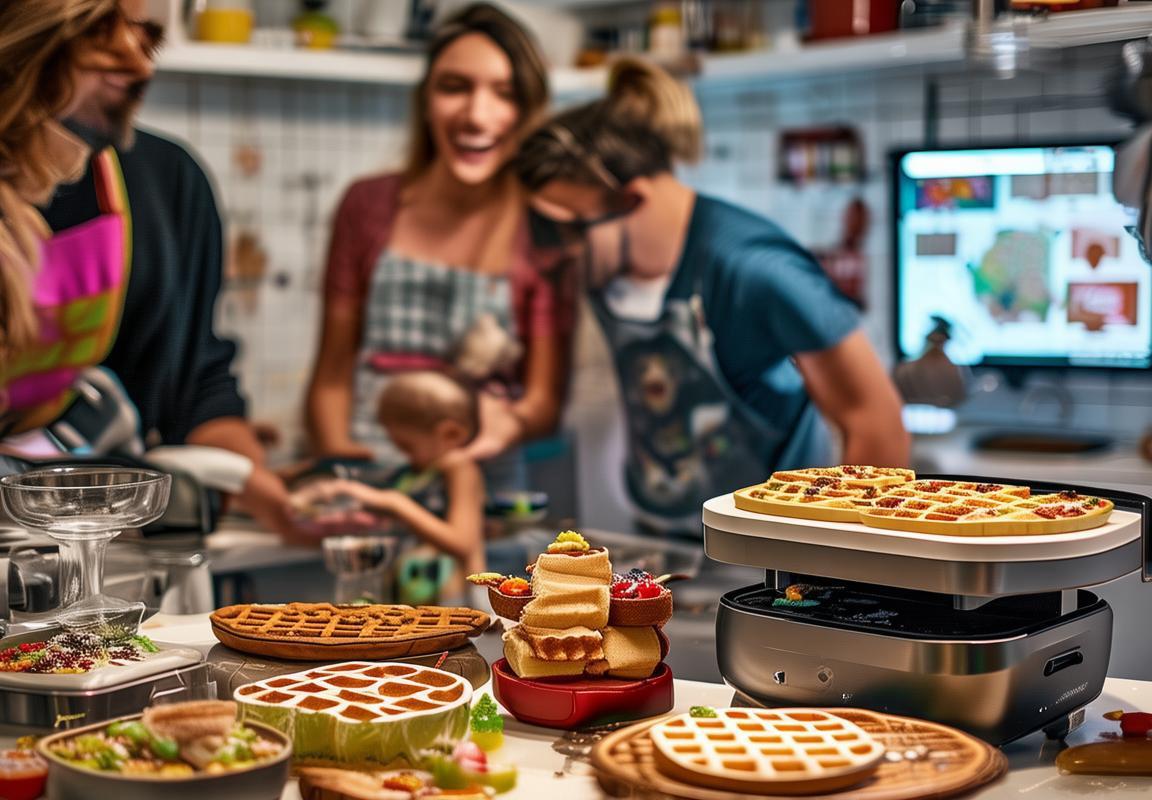
Future Outlook and Predictions for the Industry
The commercial waffle maker industry has seen a surge in demand over recent years, particularly in Western markets. Factors such as growing health consciousness, increased interest in home cooking, and the convenience of these appliances have contributed to this upward trend. Let’s delve into the various aspects that have fueled this growth.
-
Health and Wellness Trends: With an ever-growing focus on health and wellness, consumers are seeking out healthier alternatives to traditional breakfasts. Waffles, when made with whole grains and natural sweeteners, can fit into a balanced diet, making them a popular choice among health-conscious consumers.
-
Home Cooking Movement: The shift towards home cooking has been a significant driver in the waffle maker industry. People are looking to recreate restaurant-quality meals at home, and waffles offer a fun and customizable way to do so. From sweet to savory, the versatility of waffles has made them a staple in many households.
-
Convenience and Speed: Modern lifestyles demand convenience, and commercial waffle makers have answered that call. These appliances can produce waffles in minutes, saving time and effort for busy individuals and families. The ease of use and quick preparation time have contributed to their popularity.
-
Technological Advancements: Innovations in technology have also played a role in the rise of the commercial waffle maker industry. Features like non-stick surfaces, adjustable temperature controls, and programmable settings have made these appliances more user-friendly and efficient.
-
Customization and Personalization: Consumers today are looking for products that cater to their unique tastes and preferences. The ability to customize waffle patterns, shapes, and toppings has made these appliances even more appealing. From classic Belgian waffles to heart-shaped or even heart attack-shaped waffles, the options are endless.
-
Seasonal and Occasional Use: Waffle makers are not just for breakfast. They can be used for a variety of occasions, from casual family gatherings to festive celebrations. The versatility of waffles as a base for toppings like fresh berries, whipped cream, or savory fillings has broadened their appeal.
-
Marketing and Branding: Effective marketing strategies have also played a crucial role in the growth of the commercial waffle maker industry. Brands have leveraged social media, influencer partnerships, and engaging content to showcase the fun and creative aspects of waffles.
Despite the upward trend, the industry faces several challenges:
-
Competition: The commercial waffle maker market is highly competitive, with numerous brands vying for a share of the consumer’s wallet. Standing out in this crowded market requires innovation and a strong brand identity.
-
Quality Control: Ensuring consistent quality in commercial waffle makers is a challenge, especially as the industry expands. Consumers expect a reliable product that performs as advertised, which demands strict quality control measures.
-
Price Sensitivity: Consumers are often price-sensitive, and the cost of commercial waffle makers can vary widely. Balancing affordability with quality and features is a delicate balance for manufacturers.
-
Market Saturation: With the growing popularity of waffle makers, there is a risk of market saturation. To maintain growth, the industry must continually innovate and introduce new products that meet evolving consumer needs.
The commercial waffle maker industry has seen a remarkable rise in Western markets, driven by a combination of health trends, home cooking enthusiasm, convenience, and technological advancements. However, challenges such as competition, quality control, and market saturation remain. As the industry continues to evolve, manufacturers will need to adapt and innovate to stay ahead in this dynamic market.
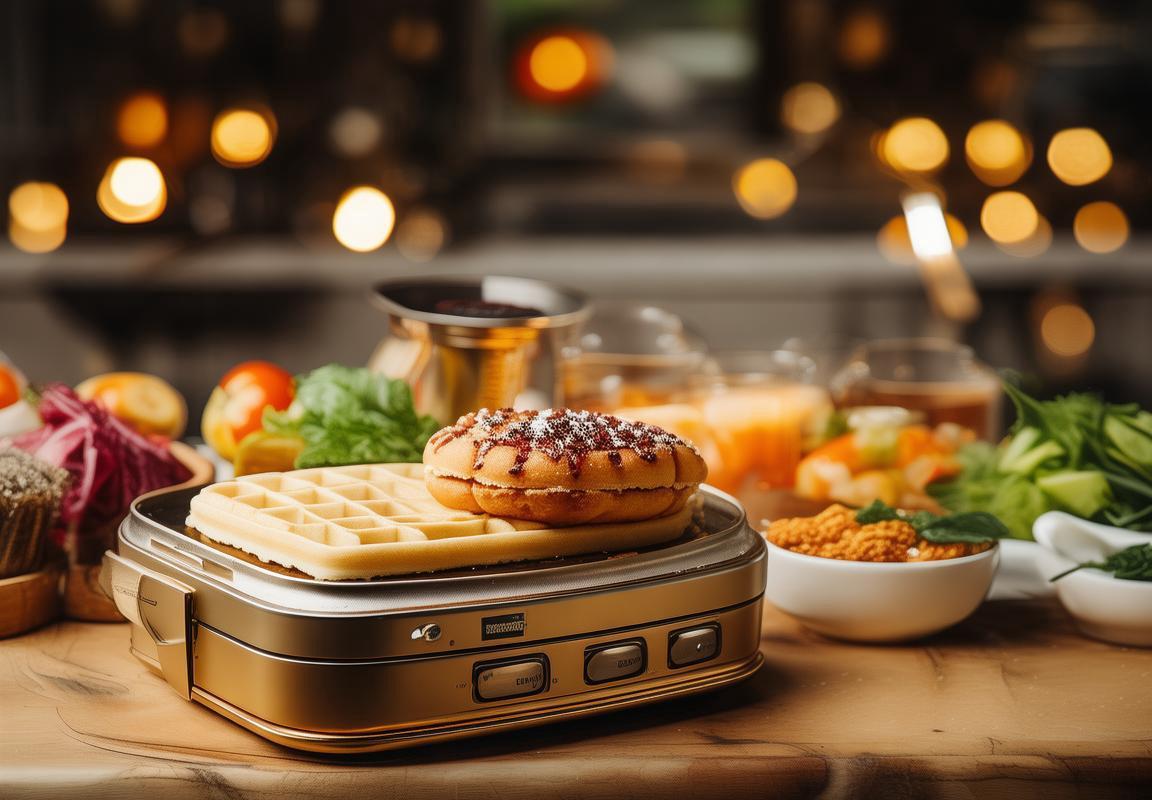
Conclusion: The Potential of the Commercial Waffle Maker Market
The commercial waffle maker market has seen remarkable growth over the years, with a significant presence in European and North American markets. This industry’s potential is fueled by a variety of factors, including shifting consumer preferences, technological advancements, and innovative product designs. In this conclusion, we’ll delve into the potential of the commercial waffle maker market, exploring the opportunities and challenges that lie ahead.
One of the key factors contributing to the potential of the commercial waffle maker market is the increasing demand for convenience and quick breakfast options. As consumers juggle busy lifestyles, there’s a growing trend towards time-saving appliances that can deliver delicious and customizable breakfasts in a matter of minutes. This has opened up a vast market for commercial waffle makers, which can cater to both individual consumers and commercial establishments such as cafes, hotels, and restaurants.
The rise of health-conscious consumers has also played a significant role in shaping the market’s potential. Waffles, traditionally seen as a comfort food, have evolved to become a healthier option with the introduction of whole grain, gluten-free, and low-calorie waffle varieties. This shift has expanded the target audience for commercial waffle makers, as these appliances become more appealing to those looking for healthier alternatives to traditional breakfast options.
Another aspect of the market’s potential lies in the customization and personalization trends. With the ability to create a wide range of waffle patterns and shapes, commercial waffle makers can cater to specific customer preferences and even corporate branding needs. This has created a niche market for custom-designed waffle makers, which are used for promotional purposes and to offer unique culinary experiences in commercial settings.
Technological advancements have also contributed to the potential of the commercial waffle maker market. Features like non-stick coatings, programmable settings, and easy-cleaning mechanisms have made these appliances more user-friendly and appealing to both consumers and commercial users. Additionally, innovations in materials and construction have led to longer-lasting and more durable waffle makers, which add to the market’s potential.
In terms of distribution channels, the commercial waffle maker market has seen a diversification in the ways products reach consumers. Online sales have become increasingly popular, with e-commerce platforms providing a convenient and accessible way for consumers to purchase these appliances. This shift has been further supported by the rise of social media marketing, where influencers and food enthusiasts showcase their waffle creations, driving interest and sales.
Furthermore, the market has seen a rise in direct-to-consumer (DTC) strategies, where manufacturers sell their products directly to consumers through their own websites or branded stores. This approach allows companies to build a loyal customer base and maintain better control over the customer experience and brand perception.
The potential of the commercial waffle maker market is also influenced by the rise of foodservice and catering sectors. As these industries continue to grow, there is an increased demand for commercial-grade appliances that can withstand heavy usage and maintain consistent quality. This has opened up opportunities for specialized waffle makers designed for high-volume production, as well as for accessories and replacement parts.
However, despite the market’s potential, there are also challenges that need to be addressed. One major challenge is the intense competition within the industry. With numerous brands and models available, manufacturers must differentiate their products through unique features, superior quality, and effective marketing strategies.
Another challenge is the fluctuating raw material costs, particularly for non-stick coatings and other key components. These cost variations can impact pricing strategies and ultimately the affordability of the products for consumers.
Moreover, the environmental impact of the waffle maker market cannot be overlooked. As consumers become more environmentally conscious, there is an increasing demand for sustainable and eco-friendly products. This shift necessitates the development of greener manufacturing processes and the use of recycled materials, which can add complexity and cost to production.
In conclusion, the commercial waffle maker market holds significant potential due to the growing demand for convenience, health, customization, and technological innovation. However, it is important for manufacturers to navigate the challenges of competition, cost fluctuations, and environmental concerns to capitalize on this potential and ensure long-term success. By focusing on quality, innovation, and sustainable practices, the commercial waffle maker market can continue to thrive and meet the evolving needs of consumers and commercial users alike.